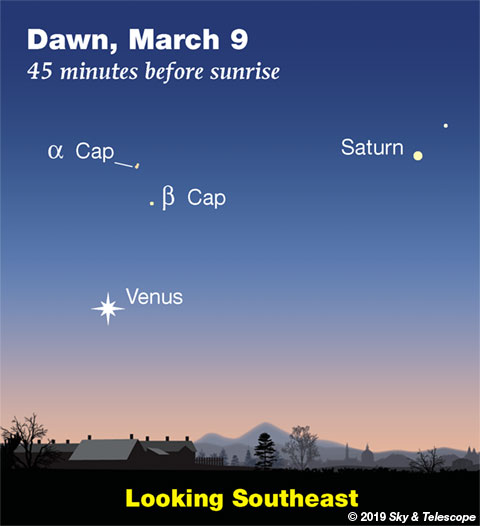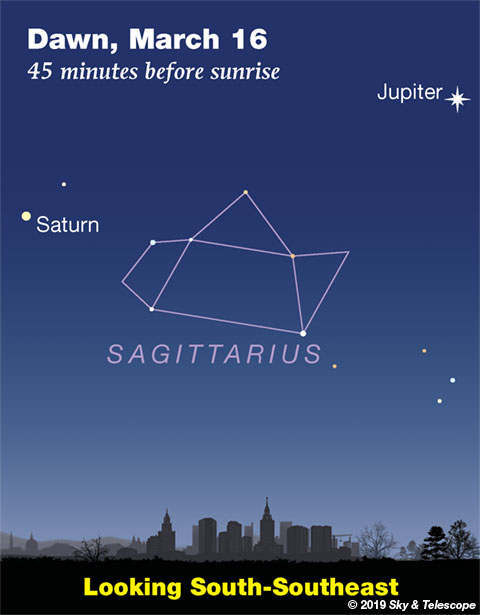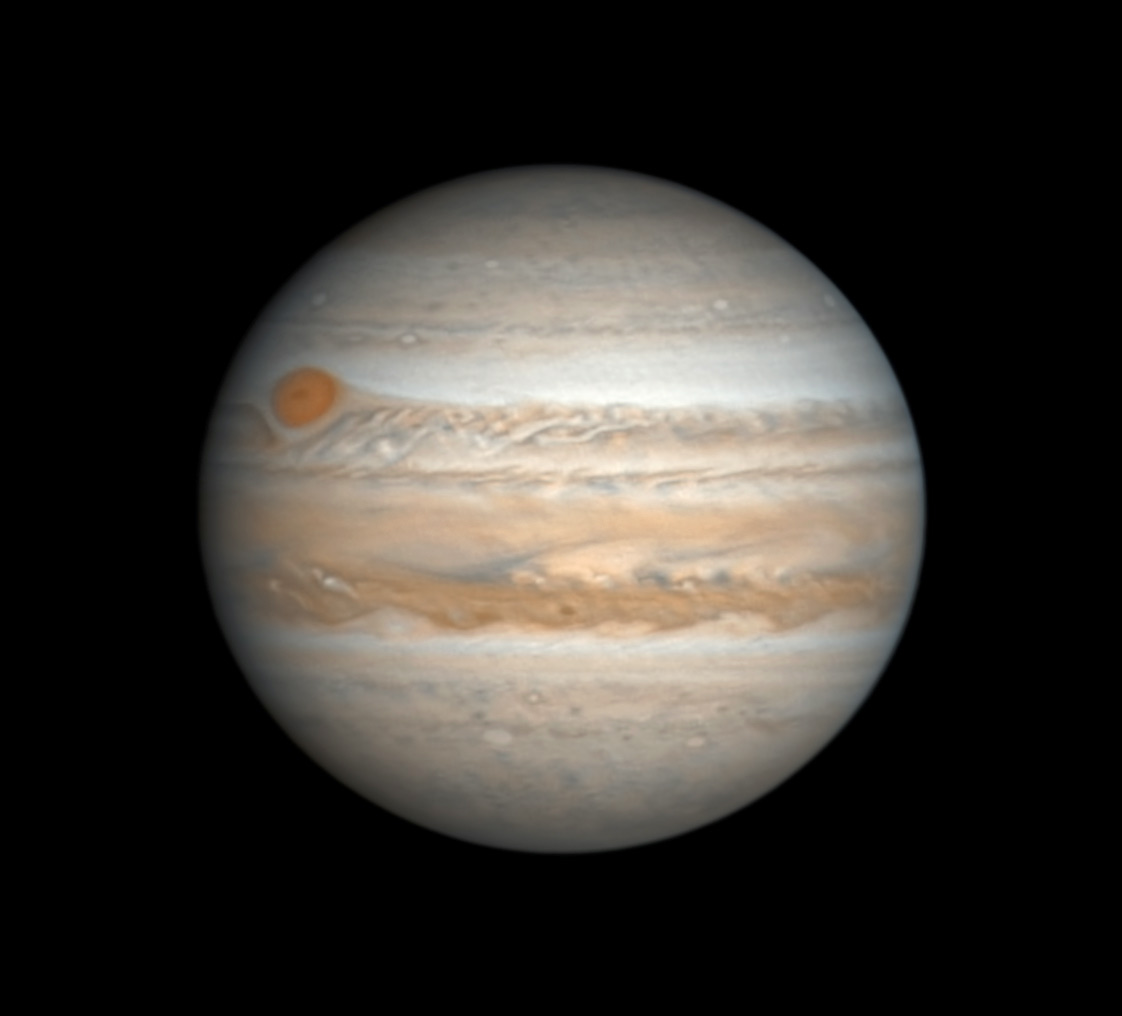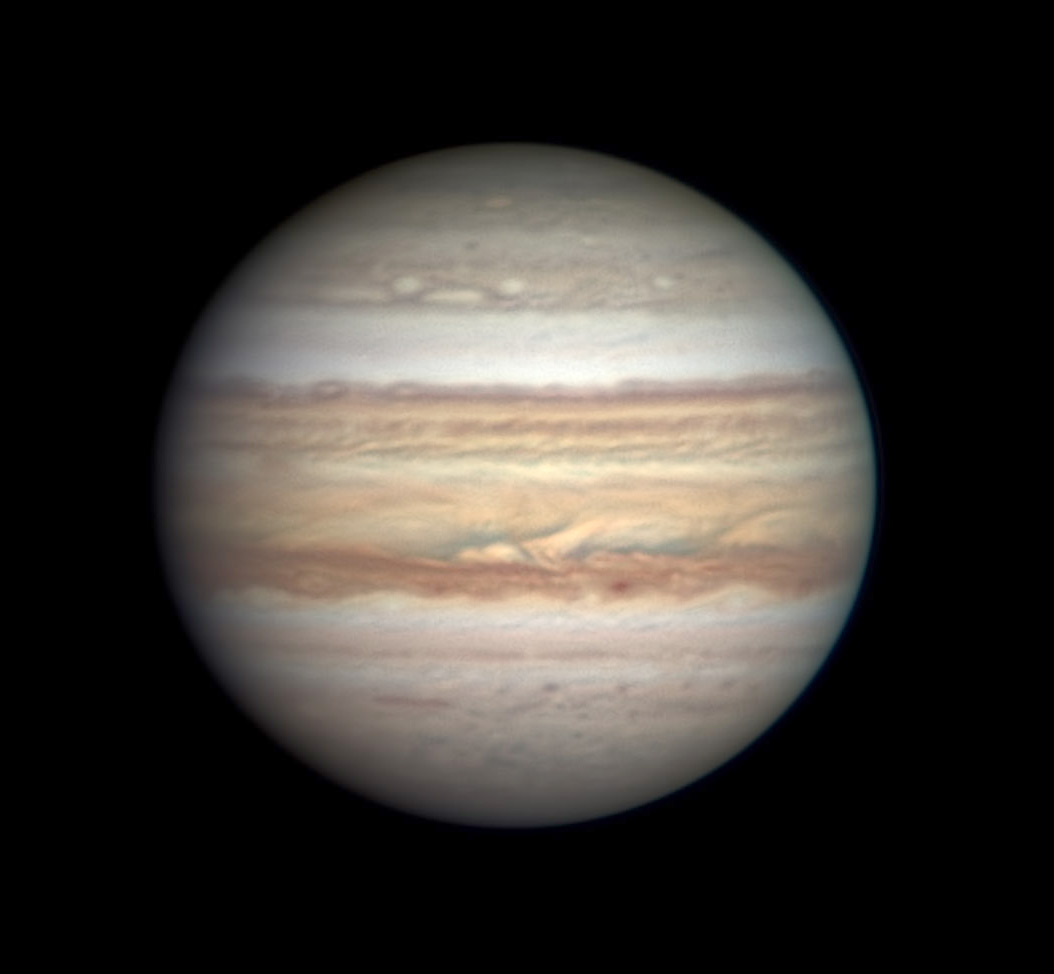
Friday, March 8
• It's not spring for another couple weeks, but the Spring Star Arcturus seems eager to take the stage. It rises above the east-northeast horizon soon after dusk now, depending on your latitude.
To see where to watch for this, find the Big Dipper high in the northeast as soon as the stars come out. Follow the curve of its handle down and around to the lower right by a little more than a Dipper-length. That's the spot on the horizon to watch.
Saturday, March 9
• By the time it's fully dark, the Big Dipper is high in the northeast and beginning to tip left. Look well to its left for Polaris and the dim Little Dipper. Other than Polaris, all you may see of the Little Dipper through moonlight or light pollution are the two stars forming the outer edge of its bowl. These are Kochab (similar to Polaris in brightness) and below it, fainter Pherkad. Find these two "Guardians of the Pole" to Polaris's lower right by about a fist and a half at arm's length.
Now is the time of year when the Guardians line up exactly vertically at the end of twilight.
• Daylight-saving time begins for most of the US and Canada at 2 a.m. tonight. Clocks "spring ahead" an hour.
Sunday, March 10
• On the traditional divide between the winter and spring sky is the dim constellation Cancer. It's between Gemini to its west and Leo to its east. Cancer holds something unique: the Beehive Star Cluster, M44, in its middle.
The Beehive shows dimly to the naked eye if you have little or no light pollution. With binoculars it's easy, even under worse conditions. Look for it a little less than halfway from Pollux in Gemini to Regulus in Leo.

Monday, March 11
• The waxing crescent Moon shines in the west to the left of Mars after dark, as shown here. Above them are the Pleiades. Left of the Pleiades is Aldebaran, the orange eye of Taurus.
Tuesday, March 12
• Now the thickening Moon is in the outskirts of the Hyades, near Taurus, as shown here.
• In a very dark sky, the full constellation stick figure of Canis Major is fairly plain to see in the south after dark. The Big Dog is seen in profile prancing on his hind legs, with Sirius as his shiny dog tag. But where many of us live, only his five brightest stars show through the light pollution — hardly doglike.
However, these form the unmistakable Canis Major Meat Cleaver. Sirius and Murzim (to its right) are the wide front end of the cleaver, with Sirius sparkling on its top back corner. Down to Sirius's lower left is the Cleaver's other end, including its short handle, formed by the triangle of Adhara, Wezen, and Aludra. Its blade is chopping toward the lower right.
Wednesday, March 13
• The Moon, barely short of first quarter now, shines in Taurus a little more than halfway from Aldebaran to Zeta Tauri, the fainter of the two horntips of Taurus. The other horntip is Beta Tauri, a little higher above the Moon.
Thursday, March 14
• First-quarter Moon; exactly so at 6:27 a.m. this morning. At nightfall about half a day later, can you see that the Moon's terminator is no longer an exact straight line?
After dark you'll see that the Moon is in the feet of Gemini, high over Orion and just above the top of Orion's very dim club (for North America).
• The yellow-eyed flying bat asterism, visible in binoculars, resides in Leo Minor near Lynx. Its wingspan extends nearly across a binocular field of view. Find it to the upper right of Leo's Sickle these evenings using Matt Wedel's Binocular Highlight column and chart in the March Sky & Telescope, page 43. As he notes, "It only flies right-side up when Pollux and Procyon are crossing the meridian," as they are now.
Friday, March 15
• Arcturus rises a half hour earlier now than it did a week ago. Look for it very low in the east-northeast after nightfall, and higher in the east later in the evening. It's magnitude 0, one of the very brightest stars in the sky.

Saturday, March 16
• The Big Dipper glitters softly high in the northeast these evenings, standing on its handle. You probably know that the two stars forming the front of the Dipper's bowl (currently on top) are the Pointers; they point to Polaris, currently to their left.
And, you may know that if you follow the curve of the Dipper's handle out and around by a little more than a Dipper length, you'll arc to Arcturus, rising in the east.
But did you know that if you follow the Pointers backward the opposite way, you'll land in Leo?
Draw a line diagonally across the Dipper's bowl from where the handle is attached, continue far on, and you'll go to Gemini.
And look at the two stars forming the open top of the Dipper's bowl. Follow this line past the bowl's lip far across the sky, and you crash into Capella.
________________________
Want to become a better astronomer? Learn your way around the constellations. They're the key to locating everything fainter and deeper to hunt with binoculars or a telescope.
This is an outdoor nature hobby. For an easy-to-use constellation guide covering the whole evening sky, use the big monthly map in the center of each issue of Sky & Telescope, the essential guide to astronomy.

Once you get a telescope, to put it to good use you'll need a detailed, large-scale sky atlas (set of charts). The basic standard is the Pocket Sky Atlas (in either the original or Jumbo Edition), which shows stars to magnitude 7.6.
Next up is the larger and deeper Sky Atlas 2000.0, plotting stars to magnitude 8.5; nearly three times as many. The next up, once you know your way around, are the even larger Interstellarum atlas (stars to magnitude 9.5) and Uranometria 2000.0 (stars to magnitude 9.75). And read how to use sky charts with a telescope.
You'll also want a good deep-sky guidebook, such as Sue French's Deep-Sky Wonders collection (which includes its own charts), Sky Atlas 2000.0 Companion by Strong and Sinnott, or the bigger Night Sky Observer's Guide by Kepple and Sanner.
Can a computerized telescope replace charts? Not for beginners, I don't think, and not on mounts and tripods that are less than top-quality mechanically (meaning heavy and expensive). And as Terence Dickinson and Alan Dyer say in their Backyard Astronomer's Guide, "A full appreciation of the universe cannot come without developing the skills to find things in the sky and understanding how the sky works. This knowledge comes only by spending time under the stars with star maps in hand."
Mercury has faded and disappeared into the sunset.
Venus (magnitude –4.0) rises above the east-southeast horizon around the first light of dawn. It's some 50° to the lower left of Jupiter.
Mars (magnitude +1.3, in Aries) glows in the west after nightfall. It's the little orange-red spark below the Pleiades. In a telescope Mars is just a tiny blob 5 arcseconds wide.


Jupiter (magnitude –2.1, in the feet of Ophiuchus) rises in the southeast around 1 or 2 a.m. It's well up in the south-southeast by the time dawn begins to brighten — its best time for telescopic observing.
Spot Antares and the head of Scorpius to Jupiter's right at that time. And swing your scope over to check in on Beta Scorpii, a fine telescopic double star. It's the top star of the upright row of three marking Scorpius's head, right or upper right of Antares.
Saturn (magnitude +0.6, in Sagittarius) glows in early dawn roughly midway between brighter Jupiter and low Venus.
Uranus is sinking out of sight in the west after dark.
Neptune is hidden behind the glare of the Sun.
______________________
All descriptions that relate to your horizon — including the words up, down, right, and left — are written for the world's mid-northern latitudes. Descriptions that also depend on longitude (mainly Moon positions) are for North America.
Eastern Standard Time (EST) is Universal Time (UT or GMT) minus 5 hours. Eastern Daylight Time (EDT) is UT minus 4 hours.
______________________
Audio sky tour. Out under the evening sky with your earbuds in place, listen to Kelly Beatty's monthly podcast tour of the heavens above. It's free.
______________________
"Science is built up of facts, as a house is with stones. But a collection of facts is no more a science than a heap of stones is a house."
— Henri Poincaré (1854–1912)
______________________
 6
6








Comments
Rod
March 8, 2019 at 10:24 am
I have clouds and rain moving in today where I live, perhaps mostly clear skies again on Monday night. M44 (Sunday March 10 info) is a very good open cluster to enjoy viewing using binoculars and telescope. On the night of 24-Feb-19, I observed M44 and M67 open clusters in Cancer using my telescope at 71x view with 1-degree true field of view. Excellent open cluster viewing. Saturn is still low in my area at 0600 local time like this morning (too cloudy to see), about 20 degrees up and 144 degrees azimuth in Sagittarius. Later Saturn will come to opposition on 08-July. Jupiter comes to opposition 09-June.
You must be logged in to post a comment.
AlphaCentauri
March 9, 2019 at 6:23 pm
Waiting for Jupiter and Saturn to get closer to the evening. I have some new eyepieces to try on them.
You must be logged in to post a comment.
Rod
March 11, 2019 at 9:21 pm
mary beth, very good views of the waxing crescent Moon tonight in Aries with Mars about 7 degree angular separation near the ecliptic. Clear skies again here in Maryland at least for a couple of nights and I was out from 1830-1945 EDT this evening. Good temperature too near 50F. Sunset at 1909 EDT for my location and by 1933 EDT, I could see earthshine on the night side of the Moon using my 90-mm refractor with 14-mm eyepiece. Very good views of terminator line and craters like Plinius, Theophilus, and Posidonius. 71x with 1-degree true field of view. Near 1938 EDT, I could see Mars, about 5" size but still resolved small planet shape at 71x. Orange-red color with some other stars in Aries in the field of view. I may be going out later for some galaxy treats in Leo, Coma Berenices, Virgo, Hercules globular clusters-could be a long night stargazing, perhaps some planet viewing of Saturn and Jupiter early tomorrow morning, and tomorrow night some more fun 🙂 Hope you folks are enjoying some clear skies in Houston. Remember, the stars shine bright, deep in the heart of Texas 🙂
You must be logged in to post a comment.
mary beth
March 12, 2019 at 3:33 pm
Hi Rod I’m so glad you’ve had a nice evening/night and even early morning of star study! You’ll have to report on the things you saw in Leo and the other constellations and clusters. Unfortunately we were cloudy but I do have good news - starting on Saturday I believe we are supposed to have at least 7 to 10 days of clear cool weather! I can’t wait! I got a kick out of your comment about Texas! Yes and I think the heart of Texas must be the Davis Mountains at the McDonald Observatory! It’s definitely not in Houston! I’m surprised anyone outside of Texas knows that song!
You must be logged in to post a comment.
Rod
March 12, 2019 at 6:04 pm
mary beth, I was born in San Antonio TX at the Army base. In 1972, I was stationed in NAS Kingsville and Corpus Christi area during the last 3 years of the Viet Nam war. Where I live, we still have some bull riders who do the rodeo riding bulls, broncos, and roping steer 🙂 Tonight looks like another lovely viewing here. I did enjoy looking at M51, the Whirlpool galaxy early this morning with my 90-mm refractor. Tonight I plan to use the 10-inch on the targets including M13 in Hercules. However, those view times are best near 0300 local for me 🙂
You must be logged in to post a comment.
mary beth
March 13, 2019 at 12:39 am
No wonder we get along so good!! You’re a Texan !
You must be logged in to post a comment.
You must be logged in to post a comment.